Passatempo Taverna’s chef Sam Shelton shares her primal instinct for the art of outdoor grilling, offering tips and recipes
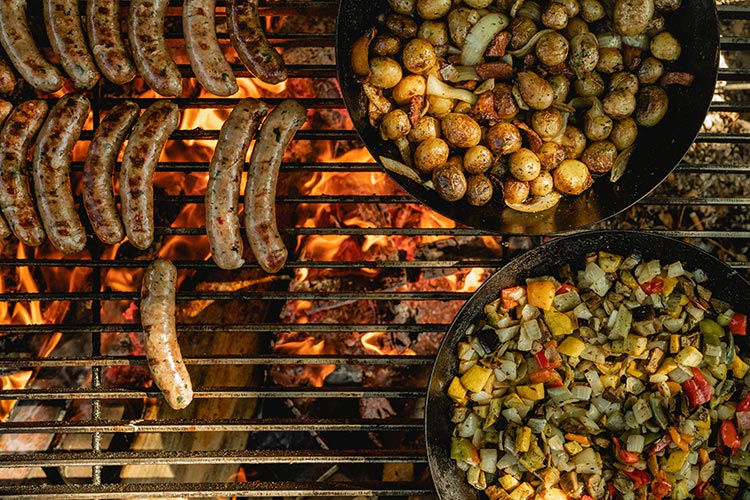
Recipes courtesy of Passatempo Taverna
Written by John Vitale
Photographs by Ben Lindbloom
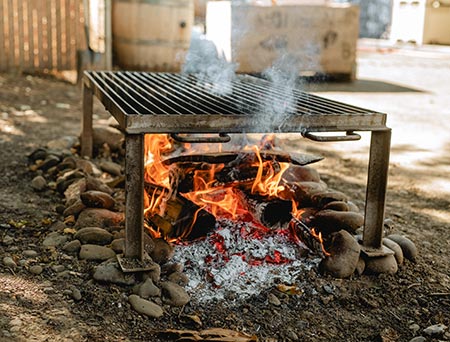
THE TAUNTING smell of seasoned applewood smoke fills the air, rising from glowing embers where a cast iron grill sits two feet above the ground next to the crush pad at The Walls Vineyards winery in Walla Walla. It is the final day of harvest and the crew of workers are weary from laboring non-stop during this demanding season. “When we really want to celebrate the last fruit or first fruit that’s coming in, which is a very big deal, we do a special lunch for the crew,” says sharp-witted chef Sam (Samantha) Shelton. “It’s ceremonial and book-ends the harvest.” Sam glides between her dual roles as executive chef and general manager of Passatempo Taverna, a downtown restaurant that opened in 2016.
Mike Martin (also owner of The Walls Vineyards) founded Passatempo with an emphasis on authentic and rustic slow-cooked Italian dishes, many built around traditional bronze-cut pastas made in-house. The restaurant also has a loyal following for the extensive menu of craft cocktails.
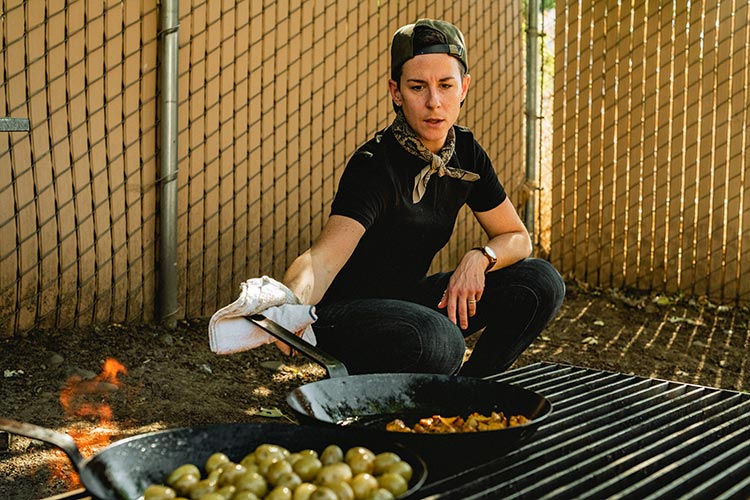
Most days Sam would be barbecuing over at the restaurant on a grill custom ordered from Italy. But today she is at the winery grilling up a hearty luncheon for the gathering of 20 or so hungry workers. She arrives well stocked with Italian sausages (locally produced at Butcher Butcher meat shop), Caesar salad and vinaigrette, chanterelle mushrooms, marble potatoes from Hayshaker Farms, and of course, enough duck fat to saute all the roasted veggies.
How long does she let the fire burn before she’s ready to grill? “I showed up first thing in the morning and built the fire, so about four hours ago. I will build it, light it, stick around for thirty minutes, make sure the wood is evenly distributed, then go back to the restaurant and finish what I’m doing, pack up and head down to the winery about an hour an a half before everyone is ready to eat,” says Sam.
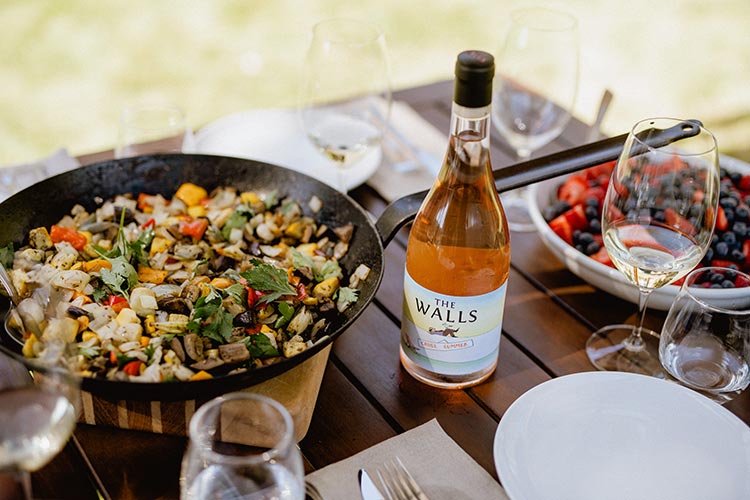
The chef elaborates on her philosophy. “Fire is a bit of an investment. It’s a lot of energy that you are creating that can last for hours. So when you’re no longer feeding the fire you should also be using that energy and heat. Obviously I’m here to cook some lunch. But I’ll try my best to use the remainder of the fire. Maybe if it’s just some big foiled packets of roasted garlic, or I’m just throwing something on the fire to char it and go back to the restaurant to use later.”
Grill Like A Pro
Grillmaster tips courtesy of chef Sam Shelton, Passatempo Taverna
Natural woods like apple, cherry or hickory offer a superior flavor compared to briquette charcoal.
Dry, dense wood burns hotter and longer than charcoal too.
Allow plenty of time to build the fire and create ample heat.
You don’t necessarily want open flames because they can be too aggressive and create uneven cooking. Wait until the fuel turns to smoldering embers and let that become your cooking surface: it’s more intense, hotter, and even.
Choose a grilling skillet that can endure high grilling heat.
Chef Sam Shelton prefers cooking with thin carbon steel pans, which offer benefits similar to those of a lightweight cast iron skillet. “Those are my go-to pans. I take the pan itself and throw it directly onto the fire, so the pan is sitting in the embers and the flames until it gets smoking hot. And then I add fat; I don’t preheat fat in a pan, I add fat to the hot skillet,” she says. “The number one key to cooking things that have a lot of retained moisture, say like mushrooms, is getting your pan so hot that by the time you add your fat—and then the product—that it never cools down.”
Be sure your products are dry and at room temperature before cooking.
“The biggest mistake people make when they’re cooking anything in a hot pan, is that the pan is not hot enough and the product itself is not room temperature and too cold,” advises chef Sam. “That’s conflicting—the product doesn’t know what to do.” She recommends letting steak sit out at room temperature 30-60 minutes before grilling because it will cook more evenly and quicker. “You’re less likely to overcook it and more likely to achieve the proper doneness,” she says.
Featured recipes below are courtesy of Passatempo Taverna
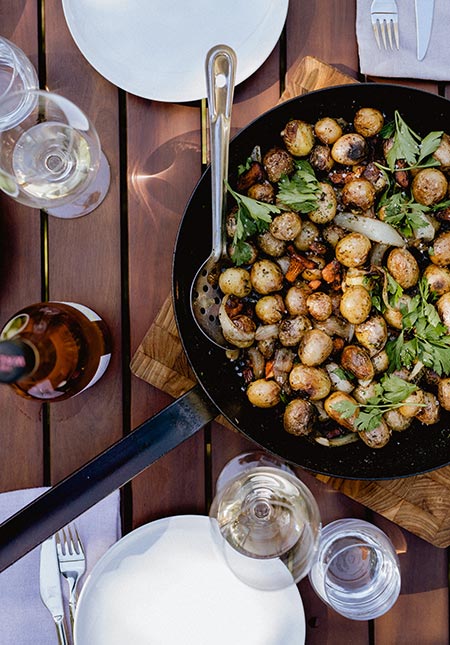 Chanterelles & Duck Fat Potatoes
Chanterelles & Duck Fat Potatoes
Replacing regular cooking oil with duck fat makes this hearty grilled vegetable dish better in every way imaginable.
Ingredients:
– 2 pounds marble potatoes, pre-boiled in salted water until cooked (20-30 minutes)
– 2 pounds chanterelle mushrooms cleaned and torn in half, stem on
– 2 tablespoons duck fat
– Chopped savory herbs, any will work (Passatempo Taverna uses equal parts parsley, rosemary, sage and chive)
– Whole roasted garlic cloves
– Maldon salt or regular sea salt
1. Preheat dry skillet on fire for 20 minutes, add two tablespoons duck fat and once melted add mushrooms, return to fire immediately.
2. Season with salt and let cook, tossing occasionally.
3. Once wilted, add cooked potatoes, season with Maldon salt, all the while leaving the skillet on the hottest area of the grill/fire. Allow potato and mushrooms to stick to pan.
4. Add garlic and season with herbs. Serve immediately.
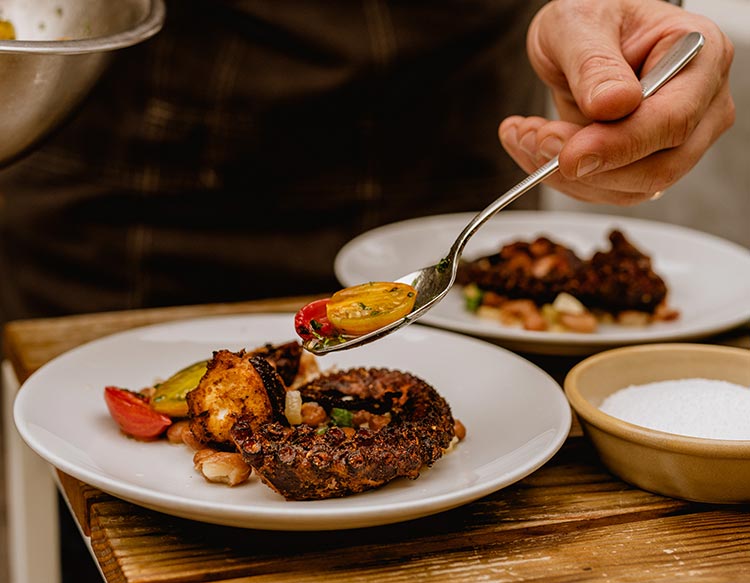 Octopus Marinade/Sauce
Octopus Marinade/Sauce
This grilled specialty dish at Passatempo Taverna requires tenderizing (simmering or braising) the octopus first, and then letting it rest overnight in this Spanish-style marinade.
Marinade Sauce:
– 1 cup dark raisins, hydrated in hot water, then strained
– 1 onion, charred on a grill
– 1/2 teaspoon ground cumin
– 1/2 teaspoon paprika
– 1/4 teaspoon cinnamon
– Salt & black pepper to taste
– Add olive oil until preferred consistency is achieved
Combine all the ingredients in a mortar & pestle, or blend until smooth. Use as a marinade or serving sauce, or both, when preparing Spanish octopus. Finish pre-cooked octopus on a hot grill.
Parmesan Vinaigrette Salad Dressing
This is a wonderfully light and tangy dressing perfect for tossing with Romaine lettuce or your favorite Caesar salad mix. Can store easily up to a week in the refrigerator if sealed in a jar or other air-tight container.
TIP: Place a whole head of Romaine lettuce on a hot grill for approximately 60 seconds (and up to 90 seconds for more wilt and char) without turning. Remove from grill and instantly chop up the leaves for your salad while still warm. Toss with vinaigrette.
VERSATILE VINAIGRETTE: Try brushing this lemony/cheesy vinaigrette on foods during grilling for enhanced flavor, such as chicken breast or portabello mushroom.
Vinaigrette Dressing: Makes approx. 1-1/4 cup
– 1/4 cup red wine vinegar
– 1 egg yolk
– 1½ teaspoons Worcestershire
– 1/2 cup grated Parmesan cheese
– 1 teaspoon fresh lemon juice
– Pinch of sea salt
– 1/8 teaspoon white pepper
– 3/4 cup bran oil (or good quality olive oil)
Put the vinegar, yolk, Worcestershire, cheese, lemon juice, salt and white pepper in blender or food processor. Pulse all ingredients while slowly pouring in the oil, about 20-30 seconds. Add more cheese or lemon juice if desired.
